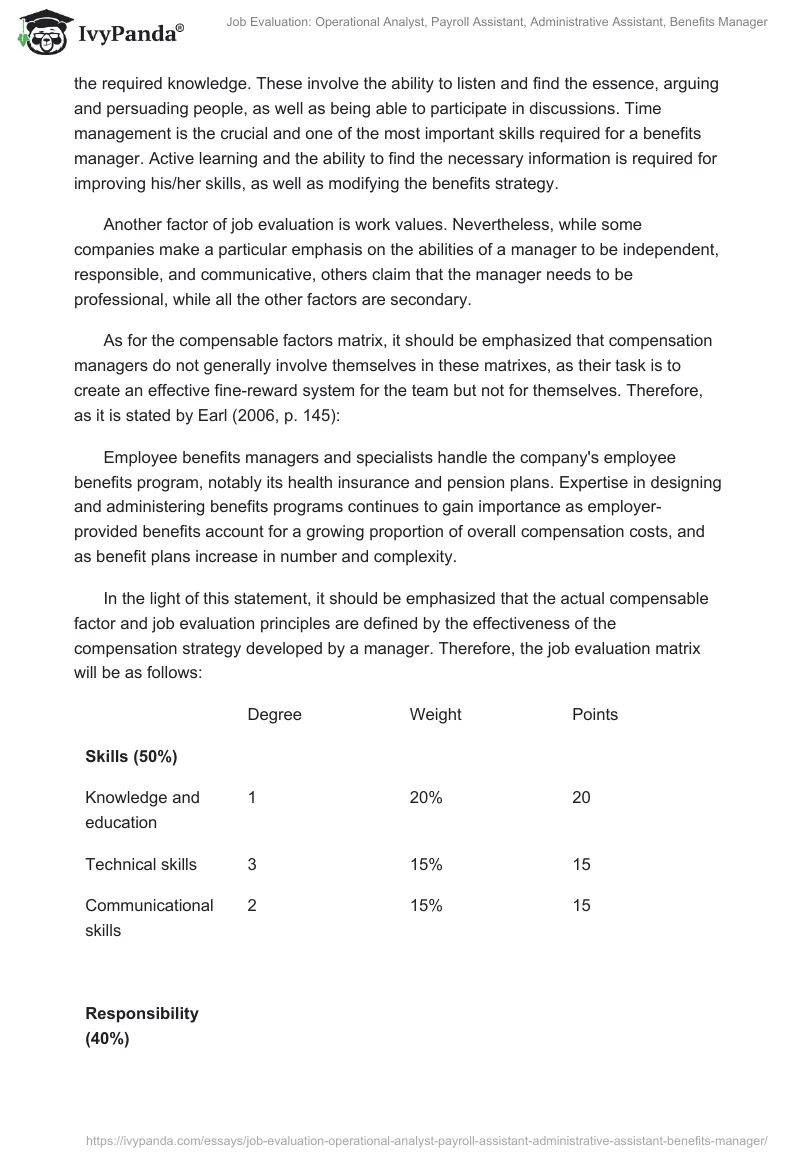Benefits Manager
The position of benefits manager is generally featured with increased responsibilities, as well as professional skills and experience in the analysis of job positions. To make the proper analysis of the position, the key tasks of the benefits manager should be analyzed. Hence, the most important tasks of benefits managers involve designing and modifying benefits policies and rules.
This is required for adjusting adequate compensation norms for workers, as well as offering innovations for the fine/reward system within the company. His/her assignments also involve analysis and reporting of possible incidents and difficulties associated with the compensation system drawbacks. This involves analysis of the possible difficulties associated with compensation principles, as well as the further offering of system improvement measures. Finally, preparing of compensation budget is also regarded as the part of benefits manager’s responsibilities.
As for the tools that are used by benefits managers, it should be stated that these are mainly media tools that are required for data storage, organization, and sharing. Additionally, managers use analytical software, HR-oriented software, as well as project management tools. These are required for optimizing the budget and compensation system development processes. Therefore, these tools help managers create clear and detailed charts and schemes for explaining their plans for department managers, as well as sharing their ideas with other team members.
Knowledge and skills that are required for proper benefits management involve personal and HR management, administration, good math skills, labor law norms, economics, and accounting, as well as the company’s strategy and principles. Professional benefits managers need to base their offers and schemes on the key principles of the company’s strategy, therefore, they should be on track of the latest changes, key aspects, and events in the company. Therefore, their skills are defined by the required knowledge. These involve the ability to listen and find the essence, arguing and persuading people, as well as being able to participate in discussions. Time management is the crucial and one of the most important skills required for a benefits manager. Active learning and the ability to find the necessary information is required for improving his/her skills, as well as modifying the benefits strategy.
Another factor of job evaluation is work values. Nevertheless, while some companies make a particular emphasis on the abilities of a manager to be independent, responsible, and communicative, others claim that the manager needs to be professional, while all the other factors are secondary.
As for the compensable factors matrix, it should be emphasized that compensation managers do not generally involve themselves in these matrixes, as their task is to create an effective fine-reward system for the team but not for themselves. Therefore, as it is stated by Earl (2006, p. 145):
Employee benefits managers and specialists handle the company’s employee benefits program, notably its health insurance and pension plans. Expertise in designing and administering benefits programs continues to gain importance as employer-provided benefits account for a growing proportion of overall compensation costs, and as benefit plans increase in number and complexity.
In the light of this statement, it should be emphasized that the actual compensable factor and job evaluation principles are defined by the effectiveness of the compensation strategy developed by a manager. Therefore, the job evaluation matrix will be as follows:
Job Evaluation
Administrative Assistant
Administrative assistant job is featured with the increased responsibility as well as the requirements for proper communicational skills. Because this assistant is among key persons in any company, his/her skills can not be regarded as a crucial requirement. Nevertheless, the responsibility of an Administrative assistant is high enough for offering additional payments and benefits. Therefore, efforts applied by the assistant may be regarded as the key motion force of the company’s administrative life. Because one of the key tasks is preparing invoices, letters, financial documentation, as well as reports, assistants should be able to react quickly for preparing the necessary documents in time. Technical and communication skills required are minimal, therefore, assistants should be able to take the responsibilities, and set the pace of document rotation.
Payroll Assistant
This position is closely linked with the necessity to consider the values implemented by the benefits manager. Therefore, all the payrolls are made by the fine-reward system accepted within the company, while the actual importance of proper payroll management depends on the ability to assess and analyze the performance of each worker, as well as consider all the possible changes in the benefits system. Another factor that should be considered is the uniqueness of the work environment. Originally, it is defined by the profile of the company, while payroll assistants have to check all the inner events of the company and calculate payrolls for each worker. Additionally, payroll assistants may be involved in timekeeping activities. This involves strict control of the attendance control and timecard control. This requires attention and data discrimination skills for reviewing and analyzing attendance and timekeeping data. (Ferguson, Muedder, et.al., 2004)
Operational Analyst
Operational analyst requires essential math and technical skills for calculating and modeling work-related problems. Because this job is mainly technical, creative thinking is strongly required for operational analysis. Even though communication skills are graded with “2”, these are also required for assessing the working situation, as well as analyzing all the possible problems associated with the operational process within an organization. Critical thinking, as the key component of the modeling process, is required for evaluating the necessary components of the analysis process, conceptualizing operational problems, performing validation of testing models, collaborating with senior managers as well as performing a decision making process for clarifying management objectives.
Reference List
Earl, M. J. (Ed.). (2006). Information Management: The Organizational Dimension. Oxford: Oxford University Press.
Ferguson, T. D., Muedder, K., & Fitzgerald, M. R. (2004). The Case for Total Absence Management and Integrated Benefits. Human Resource Planning, 24(3), 36.


